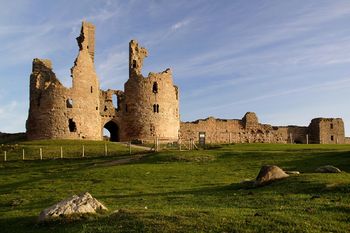Dunstanburgh Castle
Dunstanburgh Castle was founded by the Earl of Lancaster in the early 14th century. The ruins are now open to the public.
History
Dunstanburgh Castle was built in the barony of Embleton on the coast of Northumberland. Work began in 1313. Thomas, Earl of Lancaster, owned the barony and was a cousin of King Edward II. The barony was only a minor part of Thomas' estates as he also held three earldoms, those of Lancaster, Leicester, and Derby. Thomas and other magnates were jealous of the influence of Piers Gaveston in the royal court, and in 1312 Gaveston was captured at Scarborough Castle, tried, and executed. Thomas and the earl of Warwick were the main instigators of the trail. Edward II pardoned Thomas, but later that year the earl began building at Dunstanburgh, establishing a power base far from the king's centre of influence. At the time England was at war with Scotland, and in June 1314 Edward II suffered a crushing defeat at the battle of Bannockburn. In the aftermath of the battle, Edward II was heavily reliant on his cousin Thomas for the defence of northern England.[1][2]
The name Dunstanburgh was thought to be a 14th-century creation, emulating the name of nearby Bamburgh Castle however it is now thought that the -burgh suffix may refer to a previous fortification on the site. Archaeological investigations indicated that there was prehistoric or Roman activity on the site of the later castle, possibly an Iron Age promontory fort. By the time Dunstanburgh Castle was built, the area had been used as farmland for several centuries.[3]
Documents from the 16th century show that Dunstanburgh Castle was suffering from neglect.[4]
References
- ↑ Oswald, Alastair & Ashbee, Jeremy (2007). Dunstanburgh Castle. London: English Heritage. pp. 25–26. ISBN 978-1-905624-95-9.
- ↑ J. R. Maddicott, ‘Thomas of Lancaster, second earl of Lancaster, second earl of Leicester, and earl of Lincoln (c.1278–1322)’, Oxford Dictionary of National Biography, Oxford University Press, 2004; online edn, Jan 2008 accessed 6 April 2013
- ↑ Oswald & Ashbee, Dunstanburgh Castle, p. 25.
- ↑ Ashbee, Jeremy, "Research on Dunstanburgh Castle", English Heritage, accessed 6 April 2013.
